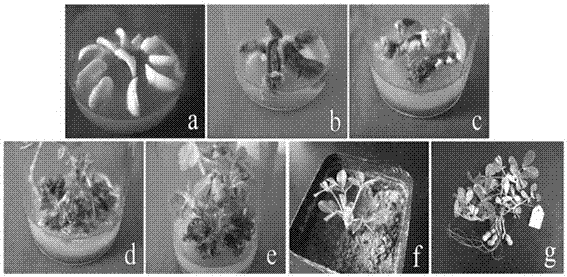Gene ahpmm related to vitamin C synthesis in peanut and its application
A technology for vitamins and peanuts, applied in the fields of application, genetic engineering, plant genetic improvement, etc., can solve the problems of functional research and transgene regulation and report gaps, and achieve the effect of improving salt tolerance and increasing vitamin C content in leaves
- Summary
- Abstract
- Description
- Claims
- Application Information
AI Technical Summary
Problems solved by technology
Method used
Image
Examples
Embodiment 1
[0031] Example 1: A peanut vitamin C synthesis-related gene AhPMM and its application in improving vitamin C content and salt tolerance
[0032] 1. Experimental materials
[0033] 1. Genes, strains and peanut varieties
[0034] The invention clones the peanut PMM gene (AhPMM), the Escherichia coli DH5α, and the Agrobacterium tumefaciens strain EHA105 are preserved in the laboratory of the Genetic Research Laboratory of Qingdao Agricultural University, and the engineered strains commercialized by biological companies can also be used. The transgenic recipient material is the peanut variety "Junan Xiaohongzhong" (provided by the Laboratory of Genetics Research Laboratory, Qingdao Agricultural University).
[0035] The sequence list of the cloned peanut AhPMM gene is shown in SEQ ID No: 1, and the amino acid sequence of the encoded protein is shown in SEQ ID No: 2.
[0036] The primer names and sequences for cloning the peanut AhPMM gene are as follows:
[0037] P1 (5'-AAATGGCTGCCCGGAAACCT...
PUM
 Login to View More
Login to View More Abstract
Description
Claims
Application Information
 Login to View More
Login to View More - R&D
- Intellectual Property
- Life Sciences
- Materials
- Tech Scout
- Unparalleled Data Quality
- Higher Quality Content
- 60% Fewer Hallucinations
Browse by: Latest US Patents, China's latest patents, Technical Efficacy Thesaurus, Application Domain, Technology Topic, Popular Technical Reports.
© 2025 PatSnap. All rights reserved.Legal|Privacy policy|Modern Slavery Act Transparency Statement|Sitemap|About US| Contact US: help@patsnap.com



